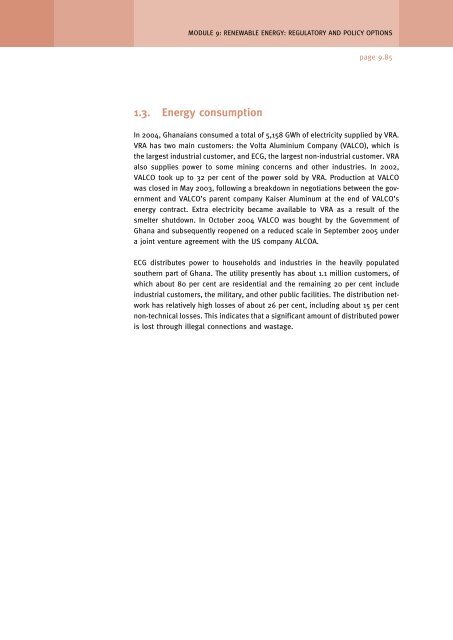SUSTAINABLE ENERGY REGULATION AND POLICYMAKING TRAINING MANUALpage 9.84<strong>of</strong> electric power, allowing VRA <strong>to</strong> export electricity <strong>to</strong> Compagnie Ivoirienned’Électricité (CIE) <strong>of</strong> Côte d’Ivoire <strong>and</strong> Communaté Électrique du Bénin (CEB) <strong>of</strong>Togo <strong>and</strong> Benin. However, as dem<strong>and</strong> grew within Ghana, the country began <strong>to</strong>face an electricity deficit. VRA now augments electric power supply by buying fromCôte d’Ivoire, which has exp<strong>and</strong>ed its generation capacity. VRA imports up <strong>to</strong> 250 MW<strong>of</strong> power from Côte d’Ivoire, <strong>and</strong> transmits power onwards <strong>to</strong> Togo <strong>and</strong> Benin.Power purchases from CIE have been mixed, with VRA having <strong>to</strong> import morepower during times <strong>of</strong> crises, for example, during the 1998 drought, which led <strong>to</strong>a drastic fall in hydro-capacity from Akosombo. Table 2 below shows the source<strong>of</strong> power supply by VRA <strong>to</strong> the Ghanaian market in 2005.Table 1. Power supply <strong>to</strong> the Ghanaian electricity market by VRA in 2003 1Generation sourceElectricity generated (GWh)Hydro 3,884Thermal 2,015Purchased from CIE 940Total 6,839There is also some st<strong>and</strong>by generation capacity available. Notably, mining companyAnglogold-Ashanti has a 21 MW diesel plant at Obuasi, <strong>and</strong> the Tema OilRefinery operates a 6.5 MW diesel plant at Tema. The Volta Reservoir receivedsubstantially above-average inflows during 1999, enabling output from Akosombo<strong>and</strong> Kpong <strong>to</strong> be raised from 3,830 GWh in 1998 <strong>to</strong> 5,169 GWh in 1999. By 2003,the water level in the lake fell again <strong>to</strong> as low as 237 feet in July <strong>and</strong> about 247feet in November. The minimum operating level <strong>of</strong> the dam is 248 feet.1.2. Transmission <strong>and</strong> distributionVRA owns <strong>and</strong> operates the nationwide transmission system <strong>and</strong> the distributionsystem for northern Ghana. The distribution system in southern Ghana is managedby the Electricity Company <strong>of</strong> Ghana (ECG). As <strong>of</strong> December 2003, the existingtransmission network system comprised <strong>of</strong> 36 substations <strong>and</strong> approximately4,000 km <strong>of</strong> 161 KV <strong>and</strong> 69 KV lines. This includes 129 km <strong>of</strong> double-circuit 161 KVinterconnection <strong>to</strong> Togo <strong>and</strong> Benin. There is also a single 220 km circuit, being a225 KV inter-tie with Côte d’Ivoire’s transmission network. The distribution systemcomprises 8,000 km <strong>of</strong> sub-transmission lines, 30,000 km <strong>of</strong> distribution networkswith 22 bulk supply points <strong>and</strong> 1,800 MVA <strong>of</strong> installed transformer capacity.1VRA Annual Report, 2003.
MODULE 9: RENEWABLE ENERGY: REGULATORY AND POLICY OPTIONSpage 9.851.3. Energy consumptionIn 2004, Ghanaians consumed a <strong>to</strong>tal <strong>of</strong> 5,158 GWh <strong>of</strong> electricity supplied by VRA.VRA has two main cus<strong>to</strong>mers: the Volta Aluminium Company (VALCO), which isthe largest industrial cus<strong>to</strong>mer, <strong>and</strong> ECG, the largest non-industrial cus<strong>to</strong>mer. VRAalso supplies power <strong>to</strong> some mining concerns <strong>and</strong> other industries. In 2002,VALCO <strong>to</strong>ok up <strong>to</strong> 32 per cent <strong>of</strong> the power sold by VRA. Production at VALCOwas closed in May 2003, following a breakdown in negotiations between the government<strong>and</strong> VALCO’s parent company Kaiser Aluminum at the end <strong>of</strong> VALCO’senergy contract. Extra electricity became available <strong>to</strong> VRA as a result <strong>of</strong> thesmelter shutdown. In Oc<strong>to</strong>ber 2004 VALCO was bought by the Government <strong>of</strong>Ghana <strong>and</strong> subsequently reopened on a reduced scale in September 2005 undera joint venture agreement with the US company ALCOA.ECG distributes power <strong>to</strong> households <strong>and</strong> industries in the heavily populatedsouthern part <strong>of</strong> Ghana. The utility presently has about 1.1 million cus<strong>to</strong>mers, <strong>of</strong>which about 80 per cent are residential <strong>and</strong> the remaining 20 per cent includeindustrial cus<strong>to</strong>mers, the military, <strong>and</strong> other public facilities. The distribution networkhas relatively high losses <strong>of</strong> about 26 per cent, including about 15 per centnon-technical losses. This indicates that a significant amount <strong>of</strong> distributed poweris lost through illegal connections <strong>and</strong> wastage.










